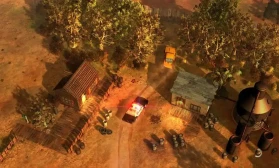Title: The Unseen Architects: Delving into the 'Place Missions' Expansion of Slug Invasion Shelter Sign Installer Simulator VR
In the vast and often bombastic landscape of virtual reality gaming, where players are typically cast as galaxy-saving heroes or fearless monster slayers, the quiet, peculiar niche of hyper-specific job simulators has carved out a devoted following. Among these, Slug Invasion Shelter Sign Installer Simulator VR stands as a monument to mundane yet bizarrely compelling gameplay. Its genius lies in transforming a seemingly trivial civic duty into a tense, strategic, and oddly meditative experience. The core game mastered the art of installing reflective signage on suburban streets under the threat of a gargantuan, slimy menace. Now, its groundbreaking expansion, Place Missions, doesn’t just add new levels; it fundamentally re-architects the player’s role within this world, evolving the installer from a simple responder into a proactive, unseen urban planner for a society on the brink.
The original game’s loop was brilliantly straightforward: an alarm blares, a map flashes with a shelter location, and you, the installer, must navigate eerily empty streets to place the correct sign (Arrow, Directional, or Illuminated ‘SAFE ZONE’) before a colossal, oozing Slug crests the horizon. The tension was pure and direct—a race against a terrifying, if slow-moving, clock. The Place Missions expansion dismantles this reactive premise. The sirens are silent here. Instead, you receive work orders from the newly established Department of Public Slug Defense (DPSD). Your task is no longer emergency response; it’s preemptive infrastructure development. You are no longer an installer; you are a planner, a surveyor, and a logistician.

This shift is immediately apparent in the new ‘Survey Mode’ integrated into your VR tablet. Before a single signpost is driven into the soil, you must first deploy to a designated neighborhood—a sprawling, labyrinthine network of cul-de-sacs, main thoroughfares, and parklands larger than any area in the base game. Your first tool isn’t a hammer or a stack of signs; it’s a sophisticated rangefinder and environmental scanner. The mission objectives are refreshingly complex: “Ensure 100% sign visibility from all 47 houses in the Pinecrest Estates subdivision, with at least two directional markers visible from any given point on the primary road network.” Or, “Establish a clear, unambiguous signage path from the commercial plaza to the designated high-capacity shelter, minimizing left-turn crossings for optimal pedestrian flow during panic.”
This turns gameplay into a captivating 3D puzzle. You must physically walk the routes, your headset’s haptic feedback providing a subtle buzz as you scan sightlines, identifying natural obstructions like ancient oak trees, decorative rock formations, or other architectural features that could obscure a sign at the critical moment. You are actively thinking like a Slug Defense urban planner. Do you place a large illuminated sign at a major intersection, knowing it’s a high-visibility asset but also a prime target for stray Slug mucus drips? Or do you opt for a more distributed network of smaller arrow signs, creating a redundant but potentially confusing path? The game now tracks metrics like ‘Path Clarity Percentage’ and ‘Average Panic Navigation Time,’ grading your performance not on speed, but on intelligent, empathetic design.
The environments themselves are characters in this expansion. Place Missions introduces a variety of new districts, each with unique aesthetic and gameplay challenges. The ‘Historic District’ forbids the use of modern metal posts, forcing you to creatively mount signs on old brick walls and wrought-iron fences without damaging the heritage infrastructure—a delicate mini-game of its own. The ‘New Construction Zone’ is a muddy, chaotic landscape of half-built homes and heavy machinery, where the path isn’t even fully formed, and you must collaborate with (non-playable) foremen to determine the final layout of roads before signs can even be considered. Then there’s the ‘Corporate Campus’ at night, where your headlamp and the glow of your tablet are your only tools for mapping escape routes through sleek, identical glass-and-steel buildings.
The expansion also deepens the lore. Audio logs from DPSD officials and civilian interviews paint a picture of a society adapting to a new normal. You overhear debates about municipal budgets for signage, complaints from homeowners’ associations about the “visual blight” of safe zone markers, and touching stories of how a well-placed sign saved a family. This world-building elevates your role. You are not just a faceless contractor; you are a vital, if anonymous, architect of public safety. The terrifying Slug incursions are still present—sometimes a “drill” will be announced, and a smaller Slug will appear to test your layout—but the fear is different. It’s not the fear of being caught; it’s the fear of having failed in your planning, of a design flaw leading people astray.
In conclusion, the Place Missions expansion is a masterclass in how to meaningfully grow a simulator game. It doesn’t just offer more of the same; it recontextualizes the entire experience. It trades the adrenaline rush of a frantic sprint for the profound, slow-burn satisfaction of meticulous craftsmanship and strategic foresight. It validates the player’s intelligence and rewards careful observation and spatial reasoning. By making you the planner, it completes the fantasy, transforming Slug Invasion Shelter Sign Installer Simulator VR from a novel curiosity into a deeply immersive and uniquely thoughtful simulation about the invisible systems that keep society functioning, even when that society is under constant threat from otherworldly gastropods. It’s a must-play for anyone who believes that true heroism isn’t always about firing a gun, but sometimes about knowing exactly where to put the sign.
Tags: #VRGaming #GameReview #SlugInvasionSimulator #JobSimulator #VirtualReality #GamingExpansion #IndieGames #SimulationGames #PlaceMissions #UniqueGames
















